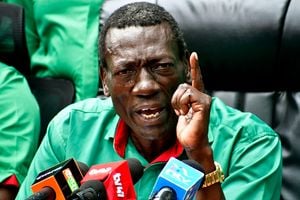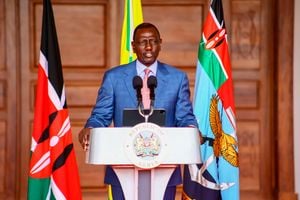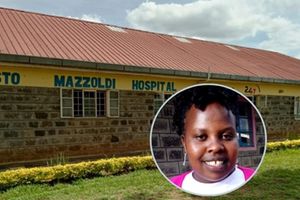
Teachers union officials, led by Knut secretary general Collins Oyuu (centre) and Kuppet secretary general Akello Misori (right) after a meeting with Teachers Service Commission in Nairobi on August 21, 2024.
Thousands of learners are returning to school from Tuesday for the crucial third term, an examination period amidst challenges besieging the education sector including strike threats from teachers.
The new Education Cabinet Secretary, Mr Julius Migos who is barely a month old has his plate full, with multiple crisis facing the sector including the impending strike, the Kenya Primary School Education Assessment (KPSEA) and the Kenya Intermediate Level Education Assessment (KILEA) and the Kenya Certificate of Secondary Education examinations.
Third term is set to begin on August 26 which will run for nine weeks.
National exams including KPSEA and the KILEA examinations are scheduled for October 28th to 31st.
Due to the phasing out of 8-4-4 from this year, there is no more Kenya Certificate of Primary Education candidates. The last KCPE cohort are in Form 1.
KPSEA is administered at Grade 6 before they transit to Junior Secondary School. However, the results are not used to place candidates in JSS but to monitor their learning progress. Learners were assessed in five subjects including Mathematics, English, Integrated Science and Kiswahili.
However, the only reprieve for Mr Migos is that for the first time in many months, schools are reopening with funds already disbursed to schools.
Mr Migos said the Sh21.8 billion funds have been released in readiness for the new school term starting August 26, 2024.
He said the release of capitation funds before the commencement of the new school term would facilitate the seamless resumption of school activities in the new term.
The amount is apportioned as follows across the three levels of basic education, Sh1.62 billion Free Primary Education Sh6.1 billion for Free Day Junior School Education and Sh14.1 billion for Free Day Secondary Education.
However, Mr Migos directed school heads and principals to ensure prudent use of these public resources warning them against imposing any unauthorized levies.
Mr Migos who is yet to meet the union leadership said he is waiting for the employer, the Teachers Service Commission, to broker the impasse.
“There is a procedure, the strike notice goes to TSC which handles that aspect first before we step in as a ministry. But the issues the unions have raised are legitimate issues relating to the Collective Bargaining Agreement, it relates to the promotion of teachers, conversion of 46,000 intern teachers into permanent and pensionable and employment of extra teachers,” said Mr Migos during an interview with Nation in Mombasa.
However, the CS said the state is facing legitimate challenges in terms of resources.
Nonetheless, the CS said the Ministry would ensure the strike was averted due to the crucial examination period.
Another headache, Mr Migos is facing is the new university funding model which has proven to be a nightmare for President William Ruto’s Kenya Kwanza administration with pressure from stakeholders including university students urging him to revert to the Differential Unit co-funding model or make it right.
Although the CS directed Vice Chancellors to admit all qualified students to register for studies regardless of whether they can pay for the household tuition contribution or not, stakeholders are still opposed to the model.
On Friday the MoE released Sh5.2 billion to the Higher Education Loans Board for tuition and upkeep loans to students joining various universities across the country from next week Monday.
Of the amount, Sh2.8 billion has been released to the Universities Fund for scholarships.
The funds are now being disbursed to the respective university and student accounts, upon ascertainment of students' reporting and admission.
Following the opening of the Higher Education Portal for this application cycle, 134,029 applications for loans and scholarships have been received to date, said Mr Migos.
A total of 127,591 applications have already been categorised into various bands. Of the categorised applicants, 12,958 have lodged appeals for re- categorisation.
“We have a situation where we are banding students between band 1-5, but there have been challenges with the Means Testing Instrument which might delay the completion of that re-banding where students are having challenges,” acknowledged the CS.
However, the CS said a portal has been opened where students who were wrongly placed (banded) can request for the right placement depending on the evidence submitted.
“Because of that we realized it might delay admission to universities so we requested the universities to admit the students as we resolve the challenge because it has to be solved. The state is releasing funds, VCs should also allow the students to learn as we conclude the exercise which will be over in two to three weeks,” said the CS.
Mombasa senator Mohammed Faki urged the state to revert to the old university model which he said was the best as it admitted students to university who got funding from HELB.
“I studied through HELB, we have to advocate for the return of the previous arrangement where all qualified students got funding from the state and you repay once you’ve concluded your course and started working,” said Mr Faki.
He said currently many students are stuck at home due to the university school fees funding crisis.
However, he is optimistic that a proposal by Changamwe MP Omar Mwinyi who urged the National Assembly to formulate a bill to amalgamate and consolidate all the education funding opportunities including bursaries and scholarships from public funds by the Ministry of Education, the National Government Constituencies Development Fund (NGCDF), County governments and financial institutions will cure education crisis and provide free universal education for all children.
In a letter to the Ministry of Education, the clerk of the National Assembly Samuel Njoroge urged the Basic Education Principal Secretary, Dr Belio Kipsang to assist in the drafting of the legislative proposal.
“I stand by my proposal, which has been received well by our National Assembly Speaker Mr Wetangula, it is the best, to cure the malady ailing our education sector. We have to make it right for our children. Schools are reopening from next week and some of our children are joining universities but there is a crisis due to funding,” said Mr Mwinyi.
He said university education has become a preserve for the rich.
Technical University of Mombasa Vice Chancellor and Prof Laila Abubakar who was also a member of the Presidential Working Party on Education Reforms, lauded the new funding model terming it student-centered.
However, she blamed its implementation.
“We are the ones who proposed that kind of funding model, unfortunately, the challenge is in implementation. When we came up with the model, the state was supposed to pay institutions of higher learning (Universities and TVETs) 80 per cent and the parent coughs only 20 per cent,” said Prof Abubakar.
However, Prof Abubakar said the model later became DUC because of some courses like Engineering, and Medicine which are practical-oriented are cost-intensive.
“When you undertake business courses you pay less but if you undertake a high-cost intensive course you pay higher fees. Unfortunately, university enrolment surged, and the state reduced funding in our institutions instead giving us 60 per cent and later 40 per cent,” said Prof Abubakar.
However, the VC said the education stakeholders decided to ensure university education is cost-shared between the parents and the state.
“Some parents are wealthy, others are poor so we decided to separate them. If you can afford an Sh100,000 fee in both primary and secondary school why would you want to pay Sh16,000 in university per year? Asked the VC.
Prof Abubakar said the student-centered model would have been successful were it not faced with teething problems in its implementation.
Her institution has already sent admission letters to 1500 students who have been categorized.
Last year, President Ruto launched the Higher Education Funding Model which began its implementation in September same year to all first-year students to correct the financial health of universities.
The model was introduced due to financial woes facing the institutions of higher learning which were owed over Sh60 billion. Under the model, beneficiaries are awarded loans, scholarships, or both, and students are classified into five bands depending on their families’ level of need.
The categorization of students is realised through a reliable scientific method, Means Testing Instrument (MTI), used to determine the student’s level of financial need, to ensure they are supported adequately.
The government support is through scholarships that are awarded by the UF and student loans that are awarded through the Higher Education Loans Board. Whereas students will not be required to pack back the scholarship component, the tuition loan and upkeep loan will be payable upon graduation and will attract a four per cent interest per year.
Under the old model, graduates only pay for the upkeep loan and the scholarship (grant) has been automatic for all government-sponsored students.










